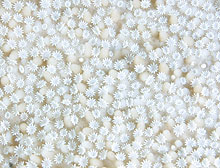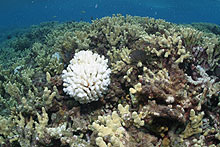NOWRAMP
2002
Coral
Bleaching
Posted by Mark Heckman, Waikiki Aquarium - University of
Hawai`i, Manoa, Education Team Member
Photography by Jim Watt
Building
a reef is a team effort. Reef building corals (1)
have evolved a symbiotic partnership with tiny, single-celled
marine algae that live inside their bodies. These algae
are called zooxanthellae (zo zan thel ay) (2).
 |
The
image to the left shows a bleached coral, Porites
evermanni. Not all of the coral is bleached however,
and even the sections that are bleached are still alive
as is shown by the extended tentacles from the polyps.
The lack of color in the bleached areas represents a
loss of zooxanthellae that give this coral a brown color. |
Imagine
that you had plant cells living in your skin. As you breathe
and burn up your food products, your body releases carbon
dioxide and waste materials - just what a plant needs. The
plant cells in your skin would take those up, create more
sugars and carbohydrates and give you a big boost of energy
that could be used to make more of your body (3).
You would have a major growth advantage over others.
Reef
building corals have come to rely on their brown, algal
plant partners. When a coral "bleaches", it simply
means that it does not have the algae present. Typically,
the zooxanthellae are lost due to some sort of stress and
here is where it gets interesting. Virtually any physiological
stress to a coral can cause bleaching. Some (but not all)
causes of coral bleaching are:
1.
Disease - there are actually a host of coral diseases. Because
corals are animals just like us, they and can get sick and
then recover or perish naturally.
2. Thermal stress - a temperature rise or fall of several
degrees for some critical period of time (hours, days or
weeks depending on the amount of change) may cause bleaching.
3. Other environmental stress - pollutants or irritants
in the water, changes in the basic pH of the ocean, high
sediment loads, from man made or natural sources, etc.
4. Visible and UV (ultraviolet) light stress - calm water
for extended periods during summer months leads to too much
sun exposure and stress. If a coral is bleached on the top,
but not the shaded sides, it may have been UV or visible
light stress.
5. Dilution of seawater - freshwater runoff form storm events
diluting seawater past optimal conditions for corals can
cause stress.
 |
The
image to the left shows a bleached coral (Montipora
capitata). From the picture you can see that the
tentacles on the polyps are extended and that the coral
is still alive. The coral may live for a few weeks without
its zooxanthellae but will eventually die if they do
not return. |
So
when it is said that a coral has "bleached", it
means that it has lost its zooxanthellae. A coral is only
a few cell layers thick and basically transparent like a
green house. When the brown zooxanthellae are removed, you
can see right through the transparent coral to the white
skeleton underneath. The coral looks white (4).
Now
the next part of the puzzle - bleached corals are not dead.
Often, if the stress is removed and things go well, the
coral will regain the zooxanthellae and be fine. But, if
not, the coral may eventually die. Define eventually? It
depends, but here are some things to consider:
1.
Many corals store lipids (fats) that seem to help them survive
prolonged periods of stress (think in terms of weeks here)
since they cannot rely on the zooxanthellae for their input
of extra energy.
2.
Some corals grow very quickly (5), so that
even if parts of the colony die, re-growth will reclaim
the lost area within a year or so.
3.
Some bleaching is "normal"; many corals bleach
a bit each year from various stress events and recover.
We just don't know much about recovery rates at this point.
4.
Sometimes one individual will bleach, while its neighbor
will not! Obviously there is variation within the coral
and zooxanthellae populations. Some deal with stress better
than others (just as is true for human populations).
 |
The
picture on the left shows a bleached coral head (Pocillopora
sp.) among Porites compressa that are not
bleached. In this case one species is bleached while
the other is not. This shows how species of coral react
differently to environmental stress. |
5.
Corals have survived for millions of years. They have dealt
with periodic hurricanes, fresh water floods, hot water
events, cold water events and so on. In the long run (hundreds
- thousands of years), they are survivors - in the short
run (human time scales), a reef may be disrupted for five,
ten, fifteen or more years before full recovery is achieved.
If the bleaching becomes "chronic" full recovery
may not happen until the stress is removed.
There
is no doubt that major bleaching events can and have occurred
on Pacific reefs in the last twenty years. This bleaching
can seriously affect local economies, fisheries and tourism
in the time it takes to recover. Long term effects, however,
are still being studied.
Coral
biology and ecology is a new field. While modern medical
research has a background of hundreds of years by thousands
of researchers, coral reef research started with Darwin
(1842) and built slowly. Many pioneers of modern coral research
are still alive, active and working to encourage the coming
generation of researchers.
Unfortunately
coral reef research is still very poorly funded. This means
that many basic questions that need to be answered have
not been. These beautiful and vital coral reefs need our
help. We need to understand these processes now, not later.
References:
Expedition Research Scientists: Dr. Jim Maragos, US Fish
and Wildlife Service; Coral Reef Biologist, Dr. Don Potts,
University of California, Santa Cruz; Dr. Greta Aeby, Coral
Biologist, Hawai`i State Department of Land and Natural
Resources.
More
information: Coral
biology and coral reefs -
an excellent series of pages about coral biology, and coral
reefs, and coral diseases.
Hot
Links
(1) There are many types of corals, some
build reefs, some do not. Corals that do not build reefs
typically do not have a significant symbiotic relationship
developed with the particular type of algae that the reef
builders do. The familiar small orange cup corals (various
species) that adorn many marine calendars and aquarium exhibits
are an example of a non-reef building coral.
<<back
(2)
Zooxanthellae are dinoflagellates, protozoans that include
a number of important single-celled marine species. Many
are planktonic, photosynthetic microscopic drifters in the
ocean waters. Many luminesce, the bioluminescence of northern
waters can be due to Noctiluca, a type of dinoflagellate.
<<back
(3)
A by product of photosynthesis is oxygen, which we need
to process the food we eat into energy and body parts -
a nice complementary cycle between plants and animals. If
you had symbiotic plants in your skin, they would not only
provide extra sugars, but would also release oxygen. For
corals, this excess oxygen may not be important, since they
are usually not found in oxygen limited environments.
<<back
(4)
Some corals have accessory pigments. Common colors include
blues and reds. When a blue coral bleaches, it will still
appear blue; the pigments are part of the coral rather than
the zooxanthellae. But the blue will be lighter or more
intense than usual since the brown zooxanthellae will be
gone.
<<back
 (5)
Growth rates for corals vary widely. Some thinly branching
corals can grow 5 - 7 inches per year per branch. Massive
corals on the other hand, have to deposit skeleton over
their entire surface and may only add ½ inch per
year. Different growth strategies have differing "payoffs".
Branching corals may grow fast, but break up easily in storm
or wave events. Massive corals can survive storms or waves,
but grow over new areas less aggressively.
(5)
Growth rates for corals vary widely. Some thinly branching
corals can grow 5 - 7 inches per year per branch. Massive
corals on the other hand, have to deposit skeleton over
their entire surface and may only add ½ inch per
year. Different growth strategies have differing "payoffs".
Branching corals may grow fast, but break up easily in storm
or wave events. Massive corals can survive storms or waves,
but grow over new areas less aggressively.
<<back
 Talk About It!
Talk About It!
Are zooxanthellae plants or animals?
Asked by Diane from Kealakehe Elementary on Feb 23, 2003.
Are zooxanthellae plants or animals? I thought Protozoans were animals and algae were plants. So is this organism both?
Answered by Mark Heckman from Waikiki Aquarium on Jun 30, 2003.
Traditionally, living things were classified into 3 to 5 kingdoms. In the most recent version, Dinoflagellates would have been in the Protista kingdom. They were not classisifed as multicellular Plantae or Animalia, but motile (mobile) single cell organisms, some of which can do photosynthesis -- sort of independent "plantamals" in this case.
With the rise of DNA coding and other advances in biology, evolutionary histories are being continually revised, and one of the more popular systems now is "3 Domains." In this scheme, most of life is in the Eukaryotic domain. These living things (including both plants and animals) all divide their cells the same way (via mitosis).
Within the three domains, the Dinoflagellates are in the Alveolates! The Alveolates have sacs under their cell membranes, and also include the familiar Ciliates (Paramecium), the Forams (of beach sand fame), and others.
So...are they plant or animal? Neither! As in the 5 Kingdom scheme, they are still an independent single-celled type of life that can do photosynthesis like a plant, but move (and sometimes eat) like an animal.
For educational purposes, we may describe them differently depending on the audience. In terms of corals, their most important fuctions are "plant like", so we may refer to them as plants if we do not have time to explain further.
Stepping up one level, I might refer to them as single-celled animals that can photosynthesize. At that point, I usually refer to the diversity within the Dinoflagellate group (which includes the bioluminescent Noctiluca, and red tide linked Gonyaulux, etc.). They may have very ancient links to the plants,but that is far back in history.
For an excellent site on current classification systems, see: http://www.ucmp.berkeley.edu/alllife/threedomains.html
